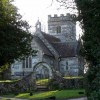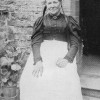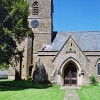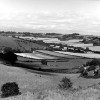Our true story begins at Powerstock, a village in West Dorset near Beaminster. You will have to decide if this tale is about the Real Lives of two lonely people seeking solace one from the other following the early passing of their spouses, or a coldly calculating couple capable of murder, twice over.
On a chilly afternoon one day early in February 1839 the Revd George Cookson, the vicar of Powerstock, found two of his parishioners at his door. They had come from the nearby hamlet of Nettlecombe to ask him to publish their marriage banns and to marry them the following month. Surprise would best describe Cookson’s reaction to this request but as he thought about the matter, surprise turned to shock.
Not twelve weeks had passed since the vicar had officiated at the burial of the man’s wife and it was just a fortnight since he had buried the woman’s husband. Those events recorded on page 60 of the parish burial register; entries 479 and 480. It is perhaps not surprising that by the following morning Cookson’s shock had turned to suspicion.
As the days passed George Cookson became increasingly vexed. He knew full well the affair would become public knowledge following the first publication of the banns and he anticipated many of his parishioners would be horrified. He was not wrong: members of the congregation at St. Mary’s considered the matter a scandal and were not slow to make their feelings known. It is no light matter to forbid the banns without good reason. The consequences could be serious but, taking full responsibility, the vicar employed someone to forbid the banns at second reading and he sent a message to Mr Frampton of Cerne Abbas, the County Coroner.
When John Hounsell and Elizabeth Gale visited their vicar they had no idea of the storm that was about to engulf them. Within a few days their dream of a married life together had turned into a nightmare that could end with the hangman dispatching them both on the long drop into eternity.
There were sufficient grounds for suspicion the Coroner agreed, and he ordered that the bodies of the departed spouses should be exhumed and an inquest take place on February 20th in the village at the Three Horse Shoes alehouse. Of what followed we have an eye-witness report.
Riding into Beaminster on the morning of February 20th our informant expecting to attend a meeting of the Board of Guardians was surprised to meet the chairman coming away from the town. “I am going to Powerstock. The doctor tells me there is an inquest to be held there this morning upon two bodies which have been exhumed and a strong suspicion of murder” said the chairman. Needing no second bidding our informant turned around and the pair was at Powerstock within the hour.
At the gate to the churchyard they found a group of men watched by half a dozen or so old people and some children. There were the Coroner, the jury, and half a dozen doctors from Beaminster and Bridport; some had been summoned to attend others were present out of curiosity. The coroner, our two observers were told by the vicar, who had joined them, had the day before sent his order for the opening of the graves and this had been done during the night. The inquest was being held at the little alehouse and the jury were now about to view the bodies. “The bodies are in their coffins in the chancel of the church,” the vicar explained to the pair, adding that he would not go into the church and went home.
The friends, on reaching the church door, were advised by the sexton to stay outside unless their presence was required. They noticed a pile of earth against the church wall and by standing on this they could see everything through the chancel window as well as if they had been inside.
The jurors, made up of small farmers and villagers, made their way up the “damp and dreary” nave evidently dreading what they were about to witness. It was a duty but on this miserable winter’s morning all of them would have preferred to be anywhere other than this place.
The two coffins had been placed unopened inside the altar rail and the coroner, the jury and the doctors gathered around. One coffin had been in the ground for three months, the other for two or three weeks. Everyone present was filled with foreboding and was dreading what would be revealed when the coffins were opened; even the doctors had little idea what to expect.
There was a pause of some minutes, broken by the coroner asking the sexton to unscrew the lids of the coffins and remove them; this he did without hesitation. Those watching through the chancel window observed one to the other that “both bodies lay in their coffins perfectly arranged…yet they had been brought down from upper rooms in cottages, they had been carried on men’s shoulder, they had been dug up again; yet in neither was there any sign of its having been shaken or disturbed. Not only were the shrouds and grave clothes in order and in decent folds, but the little branches of herbs and evergreen which had been put upon each body were just as they had been first laid.”
When asked to remove the grave clothes from the faces the sexton refused: his courage failed him. He would not listen to either command or persuasion and according to our eyewitness “drew back in evident fear.” No one else volunteered; the doctors said it was not their business, the jury members shuffled about with bowed heads and the coroner clearly believed his part in the proceedings was to give the orders. The coroner barked out his order to the sexton who eventually and much to everyone else’s relief went to the first coffin and, turning his back and averting his eyes, removed the cloth covering the woman’s face.
“The face of the dead woman was scarcely changed…every feature was distinct, the eyes scarcely sunk, the nose and mouth were natural and her black hair plainly drawn across her forehead added to the calm and almost living expression…” There was no difficulty in identifying her.
Bolstered by this experience the sexton removed the covering from the man’s face; he had been buried not three weeks but the sight was shocking to look at and beyond recognition. No one could swear that the occupant of the coffin was James Gale. Confirmation was arrived at following evidence of the carpenter and the sexton who swore that they had seen James Gale’s body in the same coffin that had been exhumed the night before and was now before them.
Satisfied with the evidence of identity the coroner hesitated about what to do next and after discussion with the doctors two of them removed the “faded old covering from the Communion table and lifted the table itself to a more convenient position, close under the light of the chancel window.” At the realisation of what was about to take place some members of the jury voiced concern: was it not bad enough that the church was being used as a kind of charnel house? The coroner decided that what had been done so far had been “done decently and with a solemn quiet and propriety.” Had he been present George Cookson, the vicar, may have taken a different view.
The doctors were instructed to carry on and after some discussion the body of the woman was taken out of her coffin, uncovered as was necessary and laid at full length upon the table. The doctors arranged their instruments and two of them rolled up their sleeves; basins of water were called for and the post mortem commenced. Several professional men were soon busy at their work and quickly fell into their usual talk and habits perhaps forgetting where they were. More than two hours passed before the examination of both bodies was completed.
Proceedings then moved to the Three Horse Shoes, a small ale house in the village. The doctors reported they had found enough arsenic in the woman’s stomach to kill half-a-dozen people. The extraordinary preservative powers of the arsenic was responsible for the body of the women and character of her face appearing unchanged from when she passed away. The result of the examination of the man’s body was less conclusive: if he had of been poisoned it must have been a vegetable poison and the doctors found nothing to prove the case one way or the other. “Wilful murder” was the verdict of the coroner’s jury.
To be continued in Part 2 when we will tell you what happened next. You will have to decide for yourself if John Hounsell was a murderer and Elizabeth Gale his willing accomplice.



